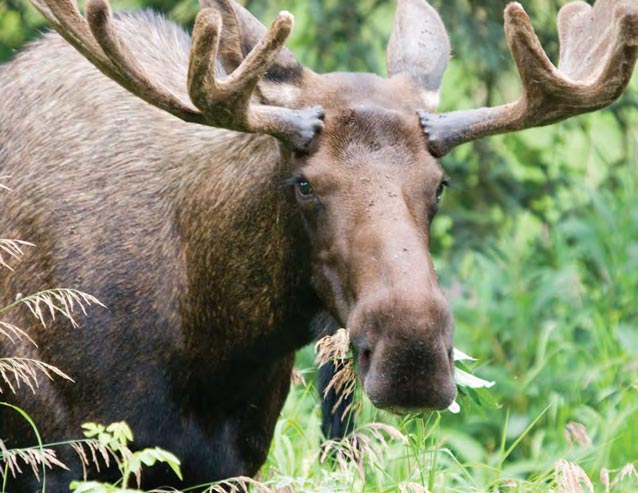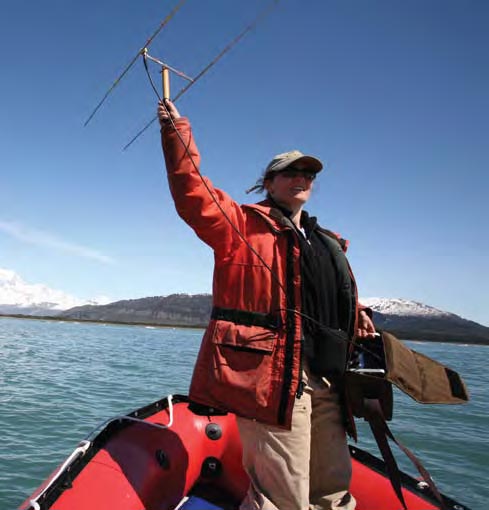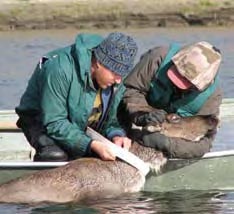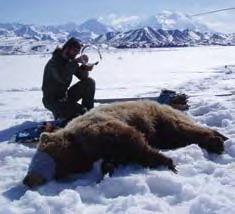
G. Gusse
Over the past several years (2004-2008) the National Parks Conservation Associa-tion (NPCA) has funded several student interns working on projects to improve the quality of information available for managing wildlife in Alaska parks. The National Park Service (NPS) partnered with NPCA by providing office space, computers, and project guidance which ultimately led to two independently produced NPCA reports: Who’s Counting and Minding the Gap. This is the story of that partnership.
Wildlife Management in Alaska National Parks
When Congress passed the Alaska National Interest Lands Conservation Act (ANILCA) in 1980, it provided both subsistence and sport hunting oppor-tunities on federal land, including those managed by the NPS. In large part this was done to preserve traditional ways of life that had evolved in Alaska. Congress emphasized this point by including subsistence hunting in the purpose statements that established many park and monument units, and by allowing sport hunting in the 19 million acres of national preserves.
Managing for wildlife harvest in this country’s national parks is not the norm. One of the key management-related provisions of the NPS Organic Act of 1916 is to “…conserve the scenery and the natural and historic objects and the wild life therein…” and that usually means no hunting. But in Alaska, where 96,000 hunting licenses were issued in 2008, managing hunting is an everyday task for the NPS. Alaska’s physically large and ecologically diverse parks, monuments, and preserves contain about a dozen mammals that are hunted or trapped for sport and subsistence throughout much of the year. From 1980 to 1990 this management responsibility was largely accomplished through regulations instituted by the State of Alaska under the auspices of a 1982 Memorandum of Understanding (MOU) between the NPS and the Alaska Department of Fish & Game.
Although the MOU is still in effect, the State fell out of compliance with federal subsistence law in 1990, causing the fed-eral government to reassert jurisdiction over subsistence hunting and trapping on its lands. The state still manages sport hunting in national preserves, leading the state and federal governments to manage separate hunts for the same wildlife. Thus the new era of “dual management” began. The Federal Subsistence Board consists of six voting members (of which NPS is one) who set regulations for subsistence hunting and trapping on federal lands, including all of Alaska NPS lands. In crafting these federal subsistence hunting regulations, the NPS realized it needed better basic information on how many animals, including moose and bear, were annually harvested from each park, and how recently population counts or productivity counts of those moose or bear had been accomplished.
Resolving these data gaps is necessary to ensure that, while hunting is provided for, specific ANILCA direction is also followed – wildlife is managed to sustain “natural and healthy” populations in national parks and monuments, and to sustain “healthy” populations in national preserves (ANILCA 815(1)). Balancing use and conservation is nothing new to the NPS, in fact, it is the defining management challenge (note 1).
In managing both sport and subsistence hunting, park managers look to the health of the hunted populations when reviewing any regulation change such as harvest limits, season length, age and sex restrictions, etc. Sustainably managing the relative health of bear, moose, or cari-bou populations is driven by population science and harvest data that are, in turn, dependant on the NPS budget (and budgets of cooperating agencies) to accomplish the work. As NPCA looked specifically into the data and science avail-able for making determinations about various species, it learned what some NPS managers had known for years – tight budgets were impacting the amount of science and retrievable harvest data avail-able to guide sound wildlife management decisions. As this discussion progressed, the needs very rapidly came into focus and a four-year partnership between the NPS and NPCA ensued. This partnership seeks to improve the usefulness of and support for both harvest data and the opportu-nity for additional science to assist the NPS in managing wildlife according to its statutory standard, maintaining wildlife populations unimpaired for the enjoyment of future generations.
The NPCA/NPS Partnership for Better Data
Collecting and analyzing harvest data for species targeted for sport hunting and subsistence hunting on Alaska national parklands had long been a desire of the NPS staff, but staff shortages made it next to impossible. Non-governmental organi-zations such as NPCA, however, are able to move quickly and nimbly to address these kinds of concerns by adjusting budget priorities, hiring interns to investigate what’s missing, summarizing findings and making recommendations in written reports.

Mason Reid
In summer 2005, NPCA recruited recent Cornell graduate Andy Moderow for a year-long internship. As Moderow settled into his NPS cubical, he dove headfirst into the voluminous database containing 25 years of harvest data. He quickly learned that there are two sources for harvest data: the Alaska Department of Fish & Game (ADF&G) annual Harvest Reporting Database, a voluntary submis-sion from successful hunters detailing what was killed, when, and where, and periodic Community Harvest Surveys, which gathered similar information from one-on-one interviews with hunters in their home communities. The NPS was keen on the state’s Harvest Reporting Database, so when Moderow learned to navigate the data labyrinth, he produced a user-friendly, searchable database com-prised of 25 years of harvest records, by species, and by park area.
The Community Harvest Surveys, which rely on personal interviews with rural residents, are more expensive and labor-intensive, so they are conducted periodically. The State of Alaska pioneered this technique and most, if not all, of these surveys have been done by the ADF&G or in cooperation with that agency. It is widely believed that this method is much more accurate for determining rural Alas-ka harvests. As of August 2006, 81 rural communities had been identified in or near parks. Most surveys for these communities are quite old.
NPCA published this year-long study and analysis of both Community Harvest Data and the Harvest Reporting Data-base in an August 2006 report titled Who’s Counting? How Insufficient Support for Science is Hindering National Park Wildlife Management in Alaska. To improve the quality of available data, the report’s conclusions recommended additional funds and/or other measures to support Community Harvest Surveys in all villages every seven to ten years, and it recommended a new NPS staff position that would be responsible for collecting, monitoring, coordinating, and under-standing wildlife harvest data from both the Harvest Reporting Database and the Community Harvest Surveys.
Who’s Counting? also recommended that the NPS obtain a better understand-ing of how many animals are living in its parks, preserves, and monuments in the first place. It suggested an analysis to measure the gap between current wildlife population studies and what biologists and managers feel is the minimum necessary to make good management decisions.
This “gap analysis” emerged from the continued partnership between NPCA and NPS in the spring of 2007 when another qualified intern was hired. Leif Mjos had just completed his under-graduate work at Prescott College and was primed and ready to begin the gap analysis.

Tina Moran
Just like Moderow, Mjos had work space, a computer, and a telephone at the NPS office, an arrangement that allowed him to receive guidance as he worked with staff from the NPS and U.S Geologi-cal Survey to design a questionnaire about the history of wildlife science in each Alaska park unit where harvest of wildlife is allowed. Kenai Fjords National Park, Sitka National Historical Park, and Klondike Gold Rush National Histori-cal Park were not surveyed because no hunting occurs there. Aniakchak was not included because of its relatively small size and remote location. All other Alaska units were included.
Due to the large number of species and the enormity of the potential material to be researched, the focus was narrowed to large hunted mammals: black bear, brown bear, caribou, moose, musk ox, sheep, and wolf. Even this was not as easy as it sounds. Wildlife biologists working for the government are involved in dozens of surveys, so Mjos’s first task was to determine what kind of surveys were being done in Alaska, and reflect that in a questionnaire which made it easy for busy NPS biologists to briefly set aside their existing work and provide the needed data.
NPS biologists stepped up to the task, and the data started coming in from around the state detailing both historical efforts and the current status of wildlife science. Mjos followed up the question-naires with a series of one-on-one inter-views asking each park’s wildlife biologists to recommend the minimal amount of research needed for the park to make wild-life harvest management decisions. From the questionnaires and interviews was born Minding The Gap: Is Wildlife Research Sufficiently Funded in Alaska’s National Parks?, published by NPCA in August 2008 (note 2).

Pat Own
While Who’s Counting? made specific recommendations for better understanding and interpretation of available harvest data, Minding The Gap revealed the need to improve basic wildlife research by identifying the gap between historical research levels and the suggested minimal research levels for selected species over time. The second report shied away from suggesting specific research priorities, which are best left to park managers, as they involve resource allocation and triage among all the competing demands for funds. The primary recommendation of both reports is for additional support and funding, which is included in the latest version of the NPS Alaska Regional Strategic Plan with “development of more robust wildlife data” as one of the plan’s priorities.
Additionally, the hope is that the NPS will improve upon what NPCA has reported by continuing to collect information on the current status of wildlife research, keeping the harvest database updated, and continuing to ask which science initiatives park managers and biologists would like to see included to close the research gap. It is NPCA’s desire to spur informed discussion about what is needed and to make the case for additional funding. And with the Centennial of the NPS just a few years away in 2016, NPCA is hopeful that these discussions will result in some creative new funding proposals, including a targeted Centennial Challenge project to increase wildlife research in Alaska.
Who’s Counting? and Minding the Gap can be found at www.npca.org/alaska/wildlife/
Notes
1. Sport hunting is permitted by a federal regulation that says “Hunting and trapping are allowed in national preserves in accordance with applicable Federal or non-conflicting state law and regulations.” (36 CFR 13.40 (d)).
2. The report recognizes its data limita-tions and recognizes there are differences between what was reported during Mjos’s internship in 2007 and where things stand today, such as the escalating cost of aviation fuel to fly wildlife surveys. Because NPCA was not able to talk to every biologist or chief of natural resources, the report also recognizes the high probability that not all data were captured.
Part of a series of articles titled Alaska Park Science- Volume 8 Issue 1: Connections to Natural and Cultural Resource Studies in Alaska's National Parks.
Last updated: August 10, 2016
